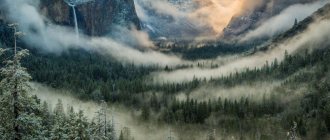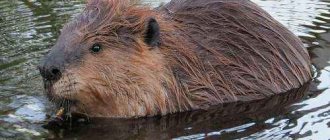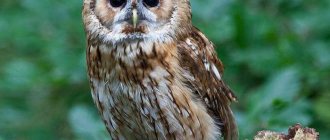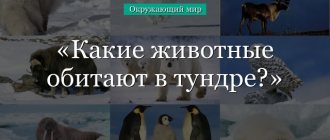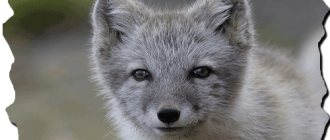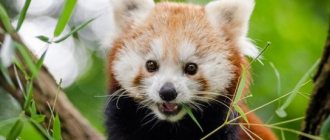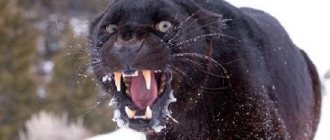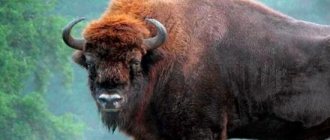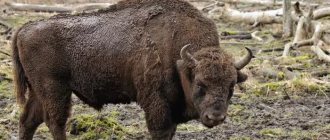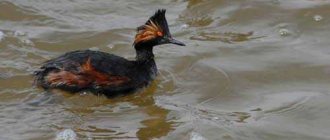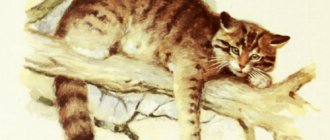Mammals
Russia is home to about 300 species of mammals, several dozen of which are rare or on the verge of extinction. Below are examples of some mammals from the Red Book of the Russian Federation.
bighorn sheep
The animal lives in Western Siberia, Chukotka and Kamchatka. It perfectly climbs rocks and mountains, which serve as protection from predators. Natural enemies are wolverine and wolf. Thick antlers are considered a hunting trophy, which is why the population of the species has fallen into severe decline. Today, bighorn sheep are primarily found in protected areas.
Narwhal
A mammal from the order of cetaceans that lives in the Arctic Ocean. Narwhals are protected from the cold by a thick layer of fat. They use their tusks to make breathing holes in the ice. The main source of food is mollusks and crustaceans, as well as bottom-dwelling fish species. The exact number is unknown. The main factors reducing the population are ocean pollution, poaching, and predation.
harbor seal
The animal lives in all seas adjacent to the Arctic Ocean. Favorite places are bays and shores protected from the wind. Natural enemies of seals include killer whales and polar bears. The number of seals is declining due to poaching, ocean pollution, and intensive human economic activity in the coastal zone.
Far Eastern leopard
A feline mammal that is teetering on the brink of extinction. These small animals live only in Southern Primorye. The leopard is threatened by people who hunt for its valuable fur. Uncontrolled deforestation is reducing the natural range of leopards. Today the species is protected in the Kedrovaya Pad nature reserve.
Red Wolf
A representative of the canine family, living in Central and South Asia. Predators living in packs hunt deer, mountain goats and wild boars. Due to the reduction in the number of deer and roe deer, the food supply of the red wolf was disrupted. The unusual color of these animals has led to interest from poachers. Today, the threat to animals is posed by their related, but at the same time competing species - the gray wolf.
Birds
The vast territory of the country is home or haven for numerous representatives of the class of birds. More than a hundred species of birds are listed in the Red Book. Many of them live in nature reserves, nature reserves or national parks in Russia.
black crane
This rare species lives in Siberia and the Far East. Birds nest and feed in swamps, steppes and forest-steppes. The food source is berries, roots, plants. The decline in population is influenced by drainage of swamps, pollution of water bodies, deforestation, and the use of pesticides in economic activities.
Siberian Crane
The endemic animal lives only in the south of Western Siberia. The bird prefers to make nests in taiga swamps. The food source is plants, crustaceans, and rodents. The population decline is due to the drying up of water bodies and their pollution of the Russian environment.
Steppe Harrier
The bird lives in Eastern Europe and Central Asia. The steppe harrier builds nests right on the ground, among thickets of bushes. It hunts rodents, reptiles and small birds. The population is on the verge of extinction due to a reduction in the food supply.
White seagull
Birds nest on the coasts of the Arctic Ocean. The decisive factor in the life of birds is the availability of food. The seagull feeds on crustaceans and fish. Scientists do not have a consensus on the decline in the species' numbers. It is hypothesized that the population is affected by environmental pollution, poaching and global warming.
Black-throated Loon
The habitat of this migratory bird is Alaska, Norway, Finland, North America and northern Russia. The loon nests in the tundra zone and on lakes. The main reason for the decline in population and migration to the north is increased human tourist and fishing activity in the coastal zone. Waterfowl get caught in fishermen's nets and die in them. Disturbed birds do not return to their nests for a long time. Loon eggs are also a source of food for predators.
Endangered birds
On the pages of the Red Book of Russia there are 123 names of birds that are in varying degrees under threat of extinction. It is these species, according to the assumptions of paleontologists, that are most likely the descendants of birds that inhabited the northern hemisphere before the glaciation period.
These relict representatives inhabit mainly the Far East of Russia - the banks of the Amur River, Primorye. Small pied whiteeye (Zosterops erythropleurus) and eastern broadmouth (Eurystomus orientalis) can be found in the groves. Scaly-sided merganser (Mergus squamatus) and rainbow mandarin duck (Aix galericulata) are found near river waters.
Endangered species of animals in Russia are practically not inferior in number to endangered species of birds.
Reptiles
The class of reptiles in Russia is represented by more than 70 species, of which about 2o are listed in the Red Book. They are found mainly in forests and along the banks of water bodies. The main negative factors for reptiles are the creation of artificial reservoirs, destruction of the coastal zone and deforestation. The growth of animal populations, for which reptiles serve as food sources, also leads to an alarming reduction in their numbers.
Far Eastern skink
The area is located on the Kuril Island Kunashir. The lizard can be found along river banks and on the edges of forests. The skink often uses other people's burrows and, in the event of an attack, can swim away from the enemy. The reason for the population decline is human economic activity and predation by the European mink.
Common copperhead
The vulnerable species of snake lives in the south of Western Siberia and the Caucasus. The copperhead is found on sun-warmed edges and undergrowth. She hides from enemies in the burrows of other animals. The food source is lizards, chicks and snakes. The main limiting factor is the use of pesticides. People often kill these rare snakes under the false belief that they are poisonous.
Gyurza
The snake is found in Transcaucasia. Its venom destroys the structure of red blood cells, making the animal deadly. The viper eats rodents, lizards and snakes. Humans are the biggest influence on population decline. He exterminates snakes for the sake of their skin, which has decorative value. Natural enemies are birds of prey.
Ringed worms in the Red Data Book of Russia
Motley Aphrodite
This is a sea worm with an oval body. The back of the animal is convex, and the abdomen is flat. You can meet it in the Sea of Japan. A few finds have been made here. The worm is easy to spot; it reaches a length of 13 centimeters and a width of 6 centimeters.
Zheleznyak
The large earthworm reaches a length of 24 centimeters and a thickness of 10 millimeters. The animal inhabits clayey soils, into which it dives to a depth of 34 meters. Iron ore can go this far during a dry period in search of moisture.
Chaetopterus
Reaches 15 centimeters in length and 1.5 in width. The body of the worm has 3 sections with different segments. In Russia, Chaetopterus lives on Sakhalin, in silt-sandy soils. So far, the finds are sporadic.
In the tropics, the worm is common. So the rarity of many Red Book animals in Russia is relative. Others, on the contrary, live only in domestic spaces and are even a curiosity here.
Amphibians
The smallest class of vertebrates in the country, numbering about 30 species. The role of amphibians is difficult to overestimate: they eat insects that are pests or carriers of various diseases. About a third of the amphibian species in Russia are in a threatened situation and are listed in the Red Book.
Triton Karelina
The animal lives in the Krasnodar region, Dagestan and Adygea. Favorite habitats are oak forests, alpine meadows and overgrown areas of reservoirs. The decrease in numbers is directly related to the drainage of water bodies. Today the species lives in the territories of Krasnodar reserves.
Reed toad
The animal lives in Karelia. The reed toad lives on the edges of forests, meadows and swamps. As a result of the development of new territories for economic activity, humans destroyed a large number of amphibians. Fortunately, the species reproduces well in captivity.
Ussuri clawed newt
This newt lives in the Far East. It lives in cold streams and on river slopes. Shading is a necessary condition for existence. The amphibian is extremely sensitive to anthropogenic changes in its habitat. Currently, the Ussuri clawed newt is found in Far Eastern nature reserves.
Fish
The number of fish declined sharply in the second half of the 20th century. The cause was factors such as uncontrolled fishing, dam construction, timber rafting, extraction of building materials, shipping, as well as pollution of water bodies with industrial waste. Most populations of valuable commercial fish species in Russia are in severe decline.
Atlantic sturgeon
The habitat is the waters of the Baltic and Black Seas, washing the shores of Russia. The fish feeds on anchovy and herring. The main negative factor for the species is mass fishing. The population has declined due to water pollution and hydraulic construction.
Brown trout
The fish lives in the Caspian, Barents, Black and Baltic seas. Trout prefer fast, cold streams. Fish are very sensitive to water quality and this is the main limiting factor. The population was also affected by mass fishing.
Chinese grouper
In Russia, this fish lives in the lower reaches of the Amur and Ussuri rivers. The predator stays in the beds of reservoirs. The food source is small non-commercial fish. The main reason for the population decline is mass fishing during the spawning season in China. Many young animals die due to lack of nutrition. Pollution of water bodies as a result of human activity has also had a significant impact on the perch population.
Insects
Insects are the largest group of animals on Earth. Science knows more than a million species of insects, and perhaps several million more species await discoverers. Most people have a negative attitude towards insects, because they bite, destroy crops and spread diseases. Nevertheless, these creatures are important links in the food chain. Russia is home to tens of thousands of insect species, of which only about a hundred are listed in the Red Book.
Stag beetle
The insect lives in the central part of European Russia. Its habitat is forests with old oaks and stumps of other trees. The limitation of the species was caused by a reduction in the food supply, forest development and cutting down of young forests.
Smooth bronze
The insect lives in the central part of Russia. Bronzewort breeds and lives in old coniferous-deciduous forests. The larvae pupate in rotten stumps. The beetles themselves feed on tree sap. The population decline is affected by the death of old trees, deforestation, fires and man-made pollution.
The most common cause of extinction of animals in Russia and the world as a whole is human activity. Uncontrolled hunting, deforestation, ocean pollution, global warming - all this threatens many species of fauna. Due to a sharp decrease in the number of animals, the mechanism of population reproduction and the balance of the ecosystem as a whole are disrupted.
Insectivores
Russian muskrat
According to scientists, this species existed and actively developed 40 million years ago, and these animals inhabited almost the entire territory of Europe. Now the number of individuals has almost halved, and their range has narrowed to isolated points in the territory of the former USSR.
Now its habitats are quite scarce; the muskrat can only be found at the mouths of the following rivers: the Dnieper, Don, Ural and Volga.
The animal is unique with its fur. The thick cover surprises with the structure of its bristles, thin towards the root and widening towards the tips. It was their magnificent age that became the reason for people's interest.
In addition to mass extermination for fur, the distribution of the species was also influenced by ecology. Large-scale cutting down of trees, pollution of rivers and lakes - all this has caused a sharp decline in the population of the Russian muskrat.
